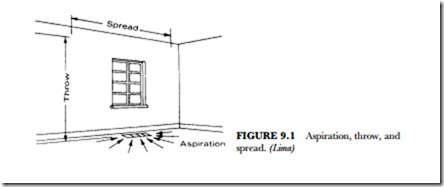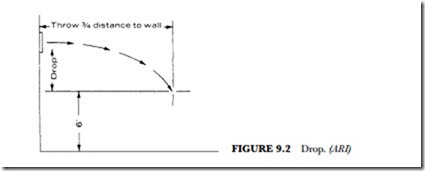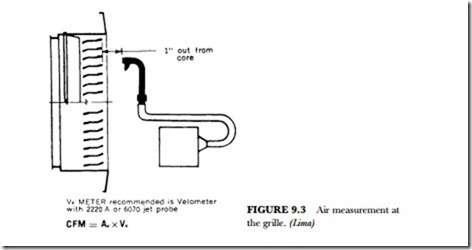AIR MOVEMENT
Convection, Conduction, and Radiation
Heat always passes from a warmer to a colder object or space. The action of refrigeration depends upon this natural law. The three methods by which heat can be transferred are convection, conduction, and radiation.
Convection is heat transfer that takes place in liquids and gases. In convection, the molecules carry the heat from one point to another. Convection can be used to remove heat from an area, and then it can be used to cool. Air or water can be cooled in one plan and circulated through pipes of radiators in another location. In this way the cool water or air is used to remove heat.
Conduction is heat transfer that takes place chiefly in solids. In conduction, the heat passes from one molecule to another without any noticeable movement of the molecules.
Radiation is heat transfer in wave form, such as light or radio waves. It takes place through a transparent medium such as air, without affecting that medium’s temperature, volume, and pressure. Radiant heat is not apparent until it strikes an opaque surface, where it is absorbed. The presence of radiant heat is felt when it is absorbed by a substance or by your body.
COMFORT CONDITIONS
The surface temperature of the average adult’s skin is 80 degrees F (26.7 degrees C). The body can either gain or lose heat according to the surrounding air. If the surrounding air is hotter than the skin temperature, the body gains heat and the person may become uncomfortable. If the surrounding air is cooler than the skin temperature, then the body loses heat. Again, the person may become uncomfortable. If the tempera- ture is much higher than the skin temperature or much cooler than the body temperature, then the person becomes uncomfortable. If the air is about 70 degrees F (21.1 degrees C) then the body feels comfortable. Skin temperature fluctuates with the temperature of the surface air. The total range of skin temperature is between 40 and 105 degrees F (4.4 and 40.6 degrees C). However, if the temperature rises 10 degrees F (5.5 degrees C), the skin temperature rises only 3 degrees F (1.7 degrees C). Most of the time the normal temper- ature of the body ranges from 75 to 100 degrees F (23.9 to 37.8 degrees C). Both humidity and temperature affect the comfort of the human body. However, they are not the only factors that cause a person to be com- fortable or uncomfortable. In heating or cooling a room, the air velocity, noise level, and temperature vari- ation caused by the treated air must also be considered.When checking for room comfort, it is best to meas- ure the velocity of the air at a distance of 4 to 72 inches from floor level. Velocity is measured with a velometer. Following is a range of air velocities and their characteristics:
• Slower than 15 feet per minute (fpm): stagnant air
• 20 fpm to 50 fpm: acceptable air velocities
• 25 fpm to 35 fpm: the best range for human comfort
• 35 fpm to 50 fpm: comfortable for cooling purposes
Velocities of 50 fpm or higher call for a very high speed for the air entering the room. A velocity of about 750 fpm or greater is needed to create a velocity of 50 fpm or more inside the room. When velocities greater than 750 fpm are introduced, noise will also be present.
Sitting and standing levels must be considered when designing a cooling system for a room. People will tolerate cooler temperatures at ankle level than at sitting level, which is about 30 inches from the floor.
Variations of 4 degrees F (2.2° C) are acceptable between levels. This is also an acceptable level for tem- perature variations between rooms.
To make sure that the air is properly distributed for comfort, it is necessary to look at the methods used to accomplish the job.
Terminology
The following terms apply to the movement of air. They are frequently used in referring to air-conditioning systems.
Aspiration is the induction of room air into the primary air stream. Aspiration helps eliminate stratification of air within the room. When outlets are properly located along exposed walls, aspiration also aids in absorbing undesirable currents from these walls and windows (see Figure 9.1).
Cubic feel per minute (cfm) is the measure of a volume of air. It is computed by multiplying the face velocity times the free area in square feet. For example, a resister with 144 square inches (1 square foot) of free area and a measured face velocity of 500 feet per minute would be delivering 500 cubic feet per minute (cfm).
Decibels (db) are units of measure of sound level. It is important to keep noise at a minimum. In most catalogs for outlets, there is a line dividing the noise level of the registers or diffusers. Lower total pressure loss provides a quieter system.
Diffusers are outlets that have a widespread, fan-shaped pattern of air.
Drop is generally associated with air that is discharged horizontally from high sidewall outlets. Since cool air has a natural tendency to drop, it will fall progressively as the velocity decreases. Measured at the point of terminal velocity, drop is the distance in feet that the air has fallen below the level of the outlet (see Figure 9.2).
Effective area is the smallest net area of an outlet utilized by the air stream in passing through the outlet passages. It determines the maximum, or jet, velocity of the air in the outlet. In many outlets, the effective area occurs at the velocity measuring point and is equal to the outlet area.
Face velocity is the average velocity of air passing through the face of an outlet or a return.
Feet per minute (fpm) is the measure of the velocity of an air stream. This velocity can he measured with a velocity meter that is calibrated in feet per minute.
Free area is the total area of the openings in the outlet or inlet through which air can pass. With gravity systems, free area is of prime importance. With forced-air systems, free area is secondary to total pressure loss, except in sizing return air grilles.
Noise criteria (nc) refer to an outlet sound rating in pressure level at a given condition of operation, based on established criteria and a specific room’s acoustic absorption value.
Occupied zone is that interior area of a conditioned space that extends to within 6 inches of all room walls and to a height of 6 feet above the floor.
Outlet area is the area of an outlet utilized by the air stream at the point of the outlet velocity as measured with an appropriate meter. The point of measurement and type of meter must be defined to determine cfm accurately.
Outlet velocity (Vk) is the measured velocity at the starting point with a specific meter.
Perimeter systems are heating and cooling installations in which the diffusers are installed to blanket the outside walls. Returns are usually located at one or more centrally located places. High sidewall or ceiling returns are preferred, especially for cooling. Low returns are acceptable for heating. High sidewall or ceiling returns are highly recommended for combination heating and cooling installations.
Registers are outlets that deliver air in a concentrated stream into the occupied zone.
Residual velocity (VR) is the average sustained velocity within the confines of the occupied zone, generally ranging from 20 to 70 fpm.
Sound power level (Lw) is the total sound created by an outlet under a specified condition of operation.
Spread is the measurement (in feet) of the maximum width of the air pattern at the point of terminal velocity (see Figure 9.4).
Static pressure (sp) is the outward force of air within a duct. This pressure is measured in inches of water. The static pressure within a duct is comparable to the air pressure within an automobile tire. A manometer measures static pressure.
Temperature differential (LlT) is the difference between primary supply and room air temperatures.
Terminal velocity is the point at which the discharged air from an outlet decreases to a given speed, generally accepted as 50 feet per minute.
Throw is the distance (measured in feet) that the air stream travels from the outlet to the point of terminal velocity. Throw is measured vertically from perimeter diffusers and horizontally from registers and ceiling diffusers (see Figure 9.1).
Total pressure (tp) is the sum of the static pressure and the velocity pressure. Total pressure is also known as impact pressure. This pressure is expressed in inches of water. The total pressure is directly associated with the sound level of an outlet. Therefore, any factor that increases the total pressure will also in- crease the sound level. The under-sizing of outlets or increases in the speed of the blower will increase total pressure and sound level.
Velocity pressure (vp) is the forward-moving force of air within a duct. This pressure is measured in inches of water. The velocity pressure is comparable to the rush of air from a punctured tire. A velometer is used to measure air velocity (see Figure 9.3).



